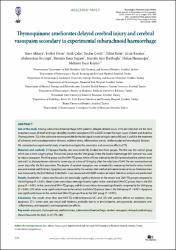Thymoquinone ameliorates delayed cerebral injury and cerebral vasospasm secondary to experimental subarachnoid haemorrhage

Göster/
Tarih
2020Yazar
Akkaya, EnesEvran, Şevket
Çalış, Fatih
Çevik, Serdar
Katar, Salim
Karataş, Ersin
Koçyiğit, Abdurrahim
Sağlam, Mustafa Yasin
Hatiboğlu, Mustafa Aziz
Hanımoğlu, Hakan
Kaynar, Mehmet Yaşar
Üst veri
Tüm öğe kaydını gösterÖzet
Aim of the study. Among subarachnoid haemorrhage (SAH) patients, delayed cerebral injury (DCI) and infarction are the most
important causes of death and major disability. Cerebral vasospasm (cVS) and DCI remain the major cause of death and disability.
Thymoquinone (TQ) is the substance most responsible for the biological activity of nigella sativa (NS) and is useful in the treatment
of ischaemic and neurodegenerative diseases, oxidative stress, inflammatory events, cardiovascular and neurological diseases.
We conducted an experimental study aimed to investigate the preventive and corrective effects of TQ.
Materials and methods. 24 Sprague-Dawley rats were randomly divided into three groups. The first was the control group
which was a sham surgery group. The second group was the SAH group where the double haemorrage SAH protocol was used
to induce vasospasm. The third group was the SAH+TQ group, where cVS was induced by the SAH protocol and the animals received oral 2 cc thymoquinone solution for seven days at a dose of 10 mg/kg, after the induction of SAH. The rats were euthanised
seven days after the first procedure. The degree of cerebral vasospasm was evaluated by measuring the basilar artery luminal
area and arterial wall thickness. Apoptosis was measured by the western blot method at brainstem neural tissue. Oxidative stress
was measured by the Erel Method. Endothelin-1 was measured with ELISA analysis at blood. Statistical analysis was performed.
Results. Endothelin-1 values were found to be statistically significantly lower in the control and SAH+TQ groups compared to
the SAH group (P < 0.001). Mean lumen area values were significantly higher in the control and SAH+TQ groups than in the SAH
group (P < 0.001). In the control and SAH+TQ groups, wall thickness values decreased significantly compared to the SAH group
(P < 0.001). OSI values were significantly lower in the control and SAH+TQ groups than in the SAH group (P < 0.001). Apoptosis
was significantly lower in the control and SAH+TQ groups than in the SAH group (P < 0.001).
Conclusion. Our results show that post-SAH TQ inhibits/improves DCI and cVS with positive effects on oxidative stress,
apoptosis, ET-1, lumen area, and vessel wall thickness, probably due to its anti-ischaemic, antispasmodic, antioxidant, anti-
-inflammatory, anti-apoptotic and neuroprotective effects.
Cilt
54Sayı
6Bağlantı
https://hdl.handle.net/11363/5347Koleksiyonlar
Aşağıdaki lisans dosyası bu öğe ile ilişkilidir:

















